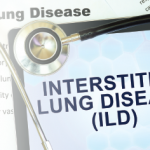In October 2015, the FDA approved nintedanib. Developed as a cancer drug, nintedanib targets multiple tyrosine kinases. Based on phase 2 data that suggested its benefit in reducing declining lung function and acute exacerbations in patients with IP, two phase 3 randomized trials (INPULSIS-1 and INPULSIS-2) were conducted to assess the efficacy and safety of nintedanib (150 mg, twice daily) in patients with IFP.3
Results of the studies showed a significant reduction in declining lung function in patients treated with nintedanib compared with placebo, with one study (INPULSIS-2) also showing a significant benefit in time to first acute exacerbation with nintedanib, whereas the other study (INPULSIS-1) found no significant difference between the two groups.
Results of the trials show that both drugs are safe, according to Dr. Noble, but also carry tolerability issues that are important and significant.

Dr. Distler
“Hope is on the horizon for the treatment of fibrotic disease,” said Oliver Distler, MD, Division of Rheumatology, University Hospital Zurich, Zurich, Switzerland, who moderated the session. The potential of these therapies to treat rheumatologic diseases is also under investigation with trials currently underway testing them in systemic sclerosis (SSc) ILD. “Nintedanib is [being tested] in a large placebo-controlled randomized clinical trial that just launched, and pirfenidone in a proof-of-concept open-label study,” he said, saying that the latter study was presented at the ACR meeting but was difficult to interpret for efficacy as it was not a controlled trial.
Dr. Noble ended his talk with a look to the future, citing three “exciting” phase II trials examining the association of IPF pathogenesis to potential therapies. The drugs being tested in these trials are Beta6 Integrin, LOXL2 and LPA receptor, all of which represent select, targeted, therapeutic approaches to IPF treatment. He said that future trials will address whether fibrosis can be reversed by targeted therapy before progression to end-stage disease.
Second Chance
If you missed this session, it’s not too late. Catch it on SessionSelect
Mary Beth Nierengarten is a writer, editor and journalist with more than 20 years of experience writing about clinical medicine and health-related issues, and lives in Minneapolis.
References
- Noble PW, Albera C, Bradford WZ, et al. Pirfenidone in patients with idiopathic pulmonary fibrosis (CAPACITY): Two randomized trials. Lancet. 2011;377:1760–1669.
- King TE Jr, Bradford WZ, Castro-Bernardini S, et al. A phase 3 trial of pirfenidone in patients with idiopathic pulmonary fibrosis. N Engl J Med. 2014;29:370:2083–2092.
- Richeldi L, du Bois RM, Raghu G, et al. Efficacy and safety of nintedanib in idiopathic pulmonary fibrosis. N Engl J Med. 2014;370:2071–2082.

